ENTREPRENEURSHIP AND SMEMIC BUSINESS MANAGEMENT INTRODUCTION 3 TASK1 3 P1. Similarities and differences between entrepreneurial ventures
VerifiedAdded on 2021/02/19
|12
|2648
|208
AI Summary
In other words, it is the human act by any individual who is able to take risk with innovative ideas for the overall growth and development of the company. In other words, it is the human act by any individual who is able to take risk with innovative ideas for the overall growth and development of the company.
Contribute Materials
Your contribution can guide someone’s learning journey. Share your
documents today.

ENTREPRENEURSHIP
AND SMALL
BUSINESS
MANAGEMENT
AND SMALL
BUSINESS
MANAGEMENT
Secure Best Marks with AI Grader
Need help grading? Try our AI Grader for instant feedback on your assignments.
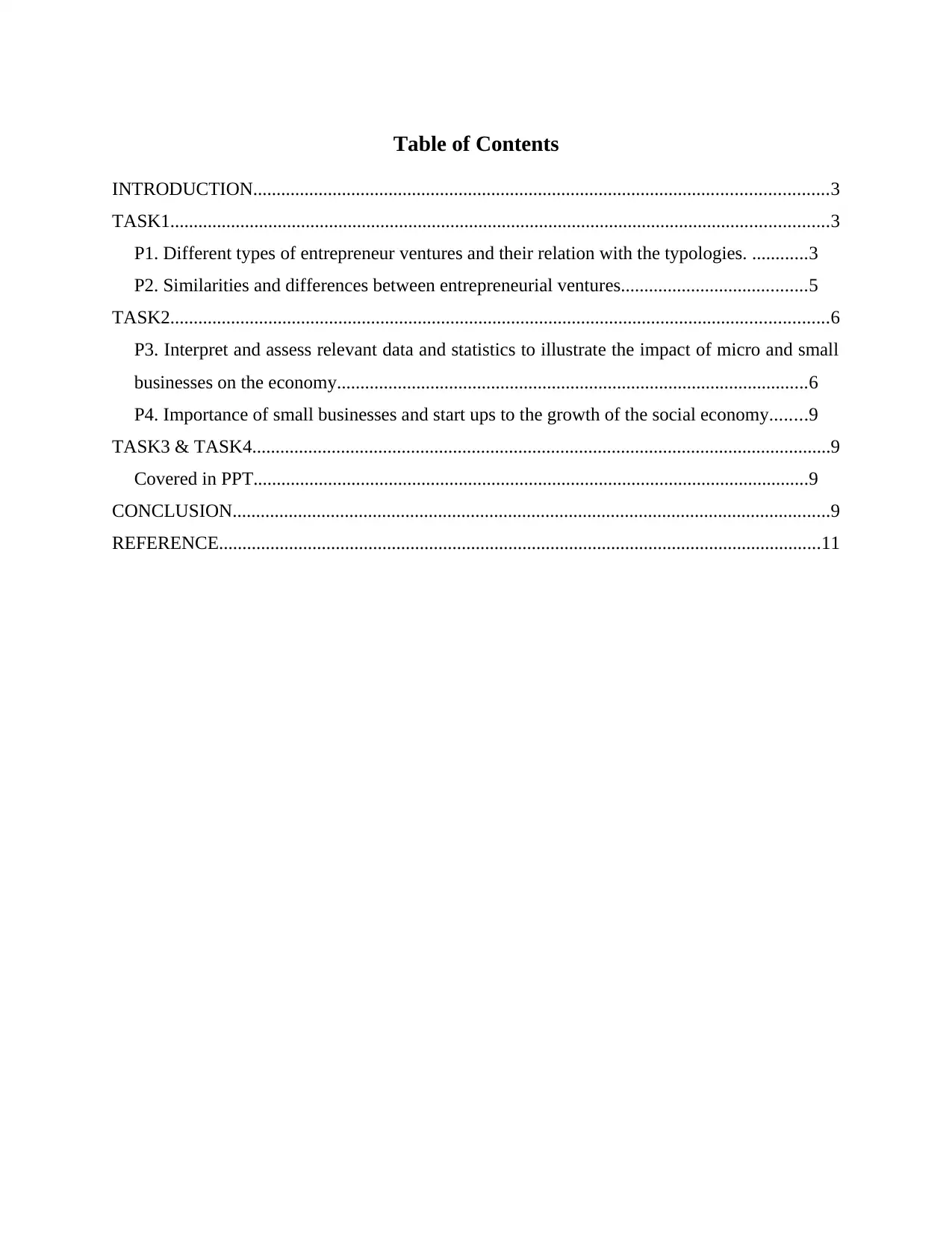
Table of Contents
INTRODUCTION...........................................................................................................................3
TASK1.............................................................................................................................................3
P1. Different types of entrepreneur ventures and their relation with the typologies. ............3
P2. Similarities and differences between entrepreneurial ventures........................................5
TASK2.............................................................................................................................................6
P3. Interpret and assess relevant data and statistics to illustrate the impact of micro and small
businesses on the economy.....................................................................................................6
P4. Importance of small businesses and start ups to the growth of the social economy........9
TASK3 & TASK4............................................................................................................................9
Covered in PPT.......................................................................................................................9
CONCLUSION................................................................................................................................9
REFERENCE.................................................................................................................................11
INTRODUCTION...........................................................................................................................3
TASK1.............................................................................................................................................3
P1. Different types of entrepreneur ventures and their relation with the typologies. ............3
P2. Similarities and differences between entrepreneurial ventures........................................5
TASK2.............................................................................................................................................6
P3. Interpret and assess relevant data and statistics to illustrate the impact of micro and small
businesses on the economy.....................................................................................................6
P4. Importance of small businesses and start ups to the growth of the social economy........9
TASK3 & TASK4............................................................................................................................9
Covered in PPT.......................................................................................................................9
CONCLUSION................................................................................................................................9
REFERENCE.................................................................................................................................11
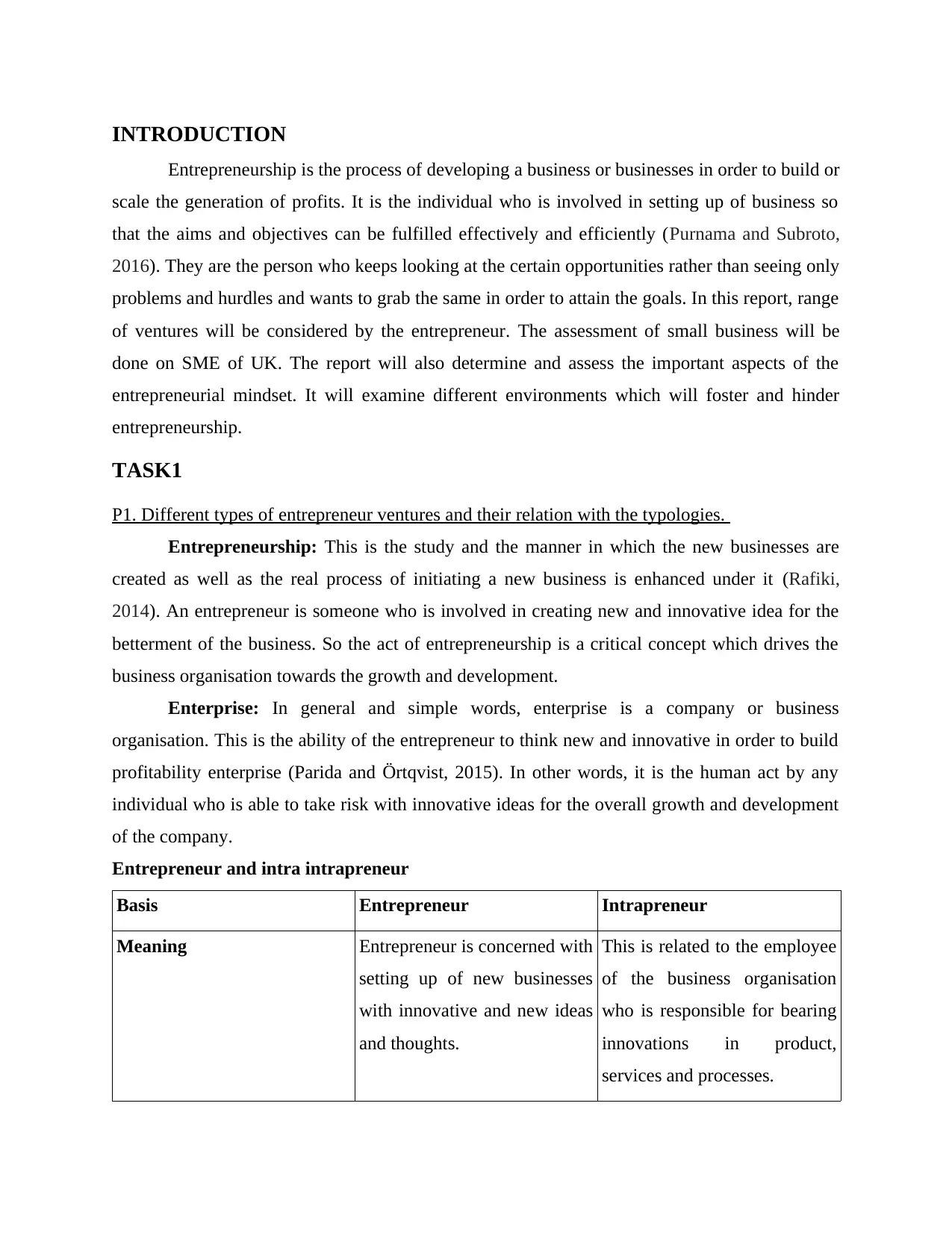
INTRODUCTION
Entrepreneurship is the process of developing a business or businesses in order to build or
scale the generation of profits. It is the individual who is involved in setting up of business so
that the aims and objectives can be fulfilled effectively and efficiently (Purnama and Subroto,
2016). They are the person who keeps looking at the certain opportunities rather than seeing only
problems and hurdles and wants to grab the same in order to attain the goals. In this report, range
of ventures will be considered by the entrepreneur. The assessment of small business will be
done on SME of UK. The report will also determine and assess the important aspects of the
entrepreneurial mindset. It will examine different environments which will foster and hinder
entrepreneurship.
TASK1
P1. Different types of entrepreneur ventures and their relation with the typologies.
Entrepreneurship: This is the study and the manner in which the new businesses are
created as well as the real process of initiating a new business is enhanced under it (Rafiki,
2014). An entrepreneur is someone who is involved in creating new and innovative idea for the
betterment of the business. So the act of entrepreneurship is a critical concept which drives the
business organisation towards the growth and development.
Enterprise: In general and simple words, enterprise is a company or business
organisation. This is the ability of the entrepreneur to think new and innovative in order to build
profitability enterprise (Parida and Örtqvist, 2015). In other words, it is the human act by any
individual who is able to take risk with innovative ideas for the overall growth and development
of the company.
Entrepreneur and intra intrapreneur
Basis Entrepreneur Intrapreneur
Meaning Entrepreneur is concerned with
setting up of new businesses
with innovative and new ideas
and thoughts.
This is related to the employee
of the business organisation
who is responsible for bearing
innovations in product,
services and processes.
Entrepreneurship is the process of developing a business or businesses in order to build or
scale the generation of profits. It is the individual who is involved in setting up of business so
that the aims and objectives can be fulfilled effectively and efficiently (Purnama and Subroto,
2016). They are the person who keeps looking at the certain opportunities rather than seeing only
problems and hurdles and wants to grab the same in order to attain the goals. In this report, range
of ventures will be considered by the entrepreneur. The assessment of small business will be
done on SME of UK. The report will also determine and assess the important aspects of the
entrepreneurial mindset. It will examine different environments which will foster and hinder
entrepreneurship.
TASK1
P1. Different types of entrepreneur ventures and their relation with the typologies.
Entrepreneurship: This is the study and the manner in which the new businesses are
created as well as the real process of initiating a new business is enhanced under it (Rafiki,
2014). An entrepreneur is someone who is involved in creating new and innovative idea for the
betterment of the business. So the act of entrepreneurship is a critical concept which drives the
business organisation towards the growth and development.
Enterprise: In general and simple words, enterprise is a company or business
organisation. This is the ability of the entrepreneur to think new and innovative in order to build
profitability enterprise (Parida and Örtqvist, 2015). In other words, it is the human act by any
individual who is able to take risk with innovative ideas for the overall growth and development
of the company.
Entrepreneur and intra intrapreneur
Basis Entrepreneur Intrapreneur
Meaning Entrepreneur is concerned with
setting up of new businesses
with innovative and new ideas
and thoughts.
This is related to the employee
of the business organisation
who is responsible for bearing
innovations in product,
services and processes.
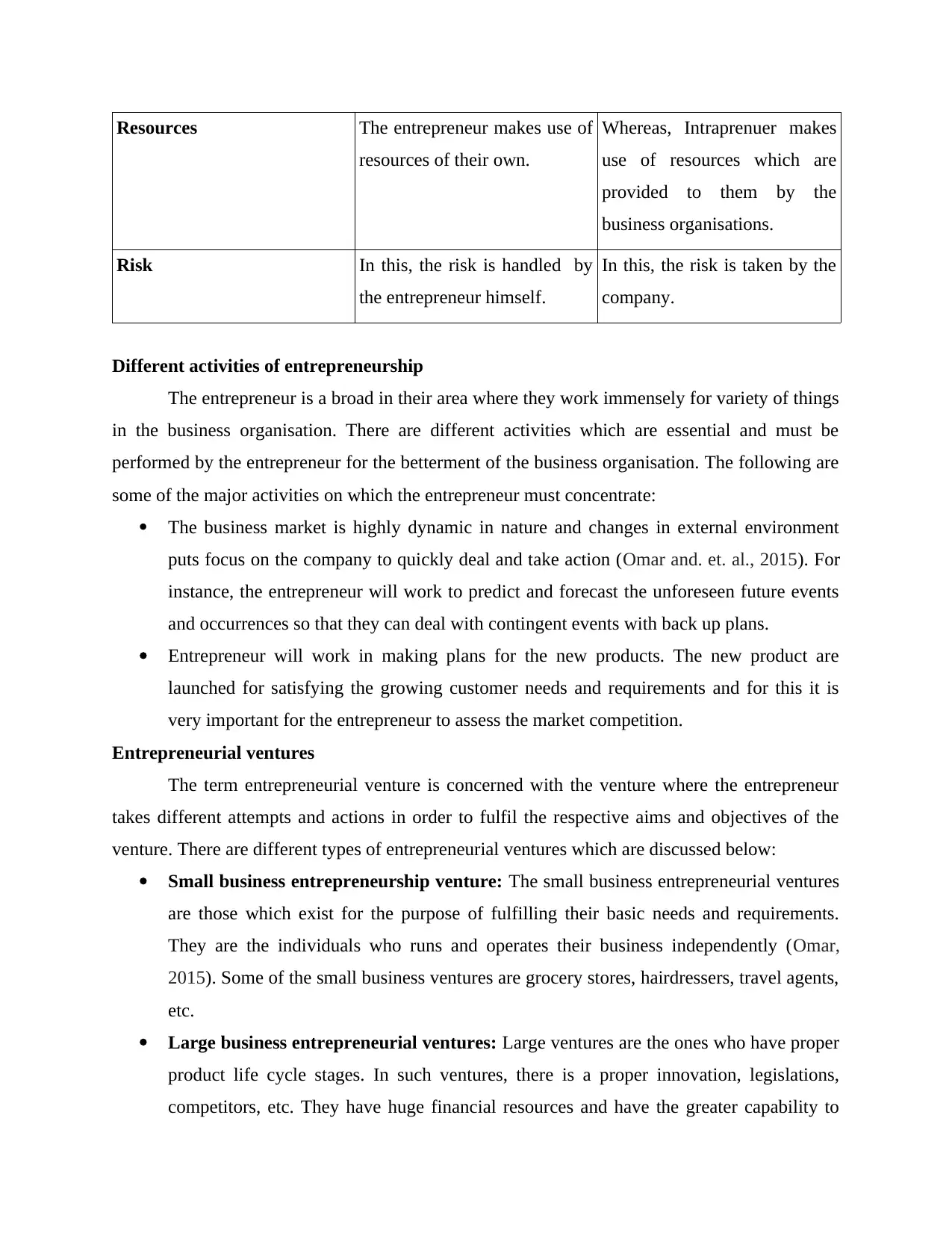
Resources The entrepreneur makes use of
resources of their own.
Whereas, Intraprenuer makes
use of resources which are
provided to them by the
business organisations.
Risk In this, the risk is handled by
the entrepreneur himself.
In this, the risk is taken by the
company.
Different activities of entrepreneurship
The entrepreneur is a broad in their area where they work immensely for variety of things
in the business organisation. There are different activities which are essential and must be
performed by the entrepreneur for the betterment of the business organisation. The following are
some of the major activities on which the entrepreneur must concentrate:
The business market is highly dynamic in nature and changes in external environment
puts focus on the company to quickly deal and take action (Omar and. et. al., 2015). For
instance, the entrepreneur will work to predict and forecast the unforeseen future events
and occurrences so that they can deal with contingent events with back up plans.
Entrepreneur will work in making plans for the new products. The new product are
launched for satisfying the growing customer needs and requirements and for this it is
very important for the entrepreneur to assess the market competition.
Entrepreneurial ventures
The term entrepreneurial venture is concerned with the venture where the entrepreneur
takes different attempts and actions in order to fulfil the respective aims and objectives of the
venture. There are different types of entrepreneurial ventures which are discussed below:
Small business entrepreneurship venture: The small business entrepreneurial ventures
are those which exist for the purpose of fulfilling their basic needs and requirements.
They are the individuals who runs and operates their business independently (Omar,
2015). Some of the small business ventures are grocery stores, hairdressers, travel agents,
etc.
Large business entrepreneurial ventures: Large ventures are the ones who have proper
product life cycle stages. In such ventures, there is a proper innovation, legislations,
competitors, etc. They have huge financial resources and have the greater capability to
resources of their own.
Whereas, Intraprenuer makes
use of resources which are
provided to them by the
business organisations.
Risk In this, the risk is handled by
the entrepreneur himself.
In this, the risk is taken by the
company.
Different activities of entrepreneurship
The entrepreneur is a broad in their area where they work immensely for variety of things
in the business organisation. There are different activities which are essential and must be
performed by the entrepreneur for the betterment of the business organisation. The following are
some of the major activities on which the entrepreneur must concentrate:
The business market is highly dynamic in nature and changes in external environment
puts focus on the company to quickly deal and take action (Omar and. et. al., 2015). For
instance, the entrepreneur will work to predict and forecast the unforeseen future events
and occurrences so that they can deal with contingent events with back up plans.
Entrepreneur will work in making plans for the new products. The new product are
launched for satisfying the growing customer needs and requirements and for this it is
very important for the entrepreneur to assess the market competition.
Entrepreneurial ventures
The term entrepreneurial venture is concerned with the venture where the entrepreneur
takes different attempts and actions in order to fulfil the respective aims and objectives of the
venture. There are different types of entrepreneurial ventures which are discussed below:
Small business entrepreneurship venture: The small business entrepreneurial ventures
are those which exist for the purpose of fulfilling their basic needs and requirements.
They are the individuals who runs and operates their business independently (Omar,
2015). Some of the small business ventures are grocery stores, hairdressers, travel agents,
etc.
Large business entrepreneurial ventures: Large ventures are the ones who have proper
product life cycle stages. In such ventures, there is a proper innovation, legislations,
competitors, etc. They have huge financial resources and have the greater capability to
Secure Best Marks with AI Grader
Need help grading? Try our AI Grader for instant feedback on your assignments.

investment in research and development department of the company. The example of this
type of venture is TESCO, Apple, etc.
Social entrepreneurial venture: It is the type of venture where individuals who are
involved in focussing on innovation and creation of new products and services which
works to accomplish the social needs and problems. Such ventures can be set up for profit
purpose, non profit purpose and even hybrid purpose. For example, NHS, Cancer
research health centre, etc.
Scalable start up venture: Under this, the business organisations initiate the company
by accompanying that their vision can change the entire world. They work immensely on
their vision because they know it can change the world in the near future (Ogunyomi and
Bruning, 2016). For instance, the Mark Zuckerberg has brought in one of the most
biggest social network which gain a lot of attention in shorter period of time that is
Facebook.
P2. Similarities and differences between entrepreneurial ventures.
Differences between the different entrepreneurial ventures
Basis Public Private Social
Meaning The public
organisations are the
ones which are run and
operated by the
government.
The private
organisations are the
ones which are
operated and directed
by private individuals.
The social
organisations are those
which are operated by
some trusts or societies
(Yuniar, 2015).
Purpose The purpose of public
organisations is to
enhance the growth
and development of
the company by
considering the needs
and requirements of
the employees and
customers.
The primary purpose
of private business
organisations is to
work effectively for
the intention of
earning more and
more money and
profits for the
company.
The purpose of this
organisation is to work
for the overall
betterment of the
society in order to
achieve and fulfil the
social benefits that will
improve the standard
of people.
type of venture is TESCO, Apple, etc.
Social entrepreneurial venture: It is the type of venture where individuals who are
involved in focussing on innovation and creation of new products and services which
works to accomplish the social needs and problems. Such ventures can be set up for profit
purpose, non profit purpose and even hybrid purpose. For example, NHS, Cancer
research health centre, etc.
Scalable start up venture: Under this, the business organisations initiate the company
by accompanying that their vision can change the entire world. They work immensely on
their vision because they know it can change the world in the near future (Ogunyomi and
Bruning, 2016). For instance, the Mark Zuckerberg has brought in one of the most
biggest social network which gain a lot of attention in shorter period of time that is
Facebook.
P2. Similarities and differences between entrepreneurial ventures.
Differences between the different entrepreneurial ventures
Basis Public Private Social
Meaning The public
organisations are the
ones which are run and
operated by the
government.
The private
organisations are the
ones which are
operated and directed
by private individuals.
The social
organisations are those
which are operated by
some trusts or societies
(Yuniar, 2015).
Purpose The purpose of public
organisations is to
enhance the growth
and development of
the company by
considering the needs
and requirements of
the employees and
customers.
The primary purpose
of private business
organisations is to
work effectively for
the intention of
earning more and
more money and
profits for the
company.
The purpose of this
organisation is to work
for the overall
betterment of the
society in order to
achieve and fulfil the
social benefits that will
improve the standard
of people.

Funded This is funded through
government of the
country (Mohammed,
Baburo and Karage,
2014).
This funded through
commercial
institutions, investors,
etc.
This is funded through
charitable institutions,
donations, trustees,
etc.
Risk There is low risk
because the
government has
enough funds to deal
with various
contingents events.
There is higher level
of risk associated
because in case of
losses the liability of
bearing the same lies
with the owner.
This is a no profit and
no loss organisations
where they work for
societal benefits in
order fulfil social
needs and
requirements.
Similarities of the public, private and social enterprise
Organisations Similarities
Public and social enterprise There is a similarity in public and social enterprises that
they both work not for the sake of earning huge amount of
profits but for the betterment of overall growth and
development of the country (Lanahan, 2016).
Private and public organisation They both are risky organisations where the risk of
external business environment will affect both of them
adversely. They develop proper contingent plans in order
to meet the impact of external forces.
TASK2
P3. Interpret and assess relevant data and statistics to illustrate the impact of micro and small
businesses on the economy.
UK is one of the largest country in the world and in present business scenario, majority of
the employees are turning themselves into the entrepreneurs. This is increasing because
government of the
country (Mohammed,
Baburo and Karage,
2014).
This funded through
commercial
institutions, investors,
etc.
This is funded through
charitable institutions,
donations, trustees,
etc.
Risk There is low risk
because the
government has
enough funds to deal
with various
contingents events.
There is higher level
of risk associated
because in case of
losses the liability of
bearing the same lies
with the owner.
This is a no profit and
no loss organisations
where they work for
societal benefits in
order fulfil social
needs and
requirements.
Similarities of the public, private and social enterprise
Organisations Similarities
Public and social enterprise There is a similarity in public and social enterprises that
they both work not for the sake of earning huge amount of
profits but for the betterment of overall growth and
development of the country (Lanahan, 2016).
Private and public organisation They both are risky organisations where the risk of
external business environment will affect both of them
adversely. They develop proper contingent plans in order
to meet the impact of external forces.
TASK2
P3. Interpret and assess relevant data and statistics to illustrate the impact of micro and small
businesses on the economy.
UK is one of the largest country in the world and in present business scenario, majority of
the employees are turning themselves into the entrepreneurs. This is increasing because

government of the country is strongly supporting the individuals who are taking initiative to start
their own businesses. As per the recent data, there are 5.7 million of SME businesses is present
in UK. The SME consist of businesses which have workforce of up to 250 employees (UK SME
Data, Stats & Charts, 2019).
their own businesses. As per the recent data, there are 5.7 million of SME businesses is present
in UK. The SME consist of businesses which have workforce of up to 250 employees (UK SME
Data, Stats & Charts, 2019).
Paraphrase This Document
Need a fresh take? Get an instant paraphrase of this document with our AI Paraphraser
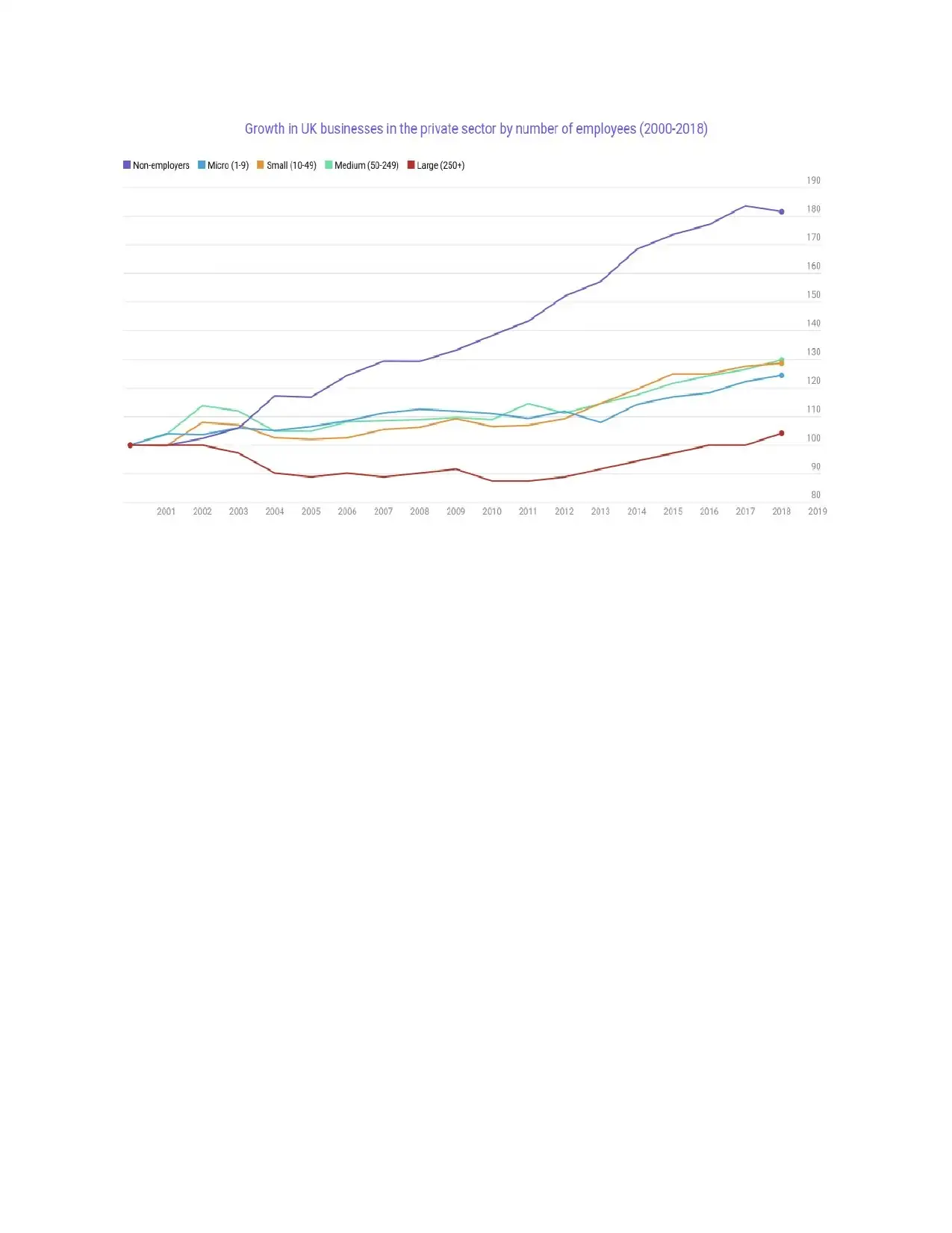
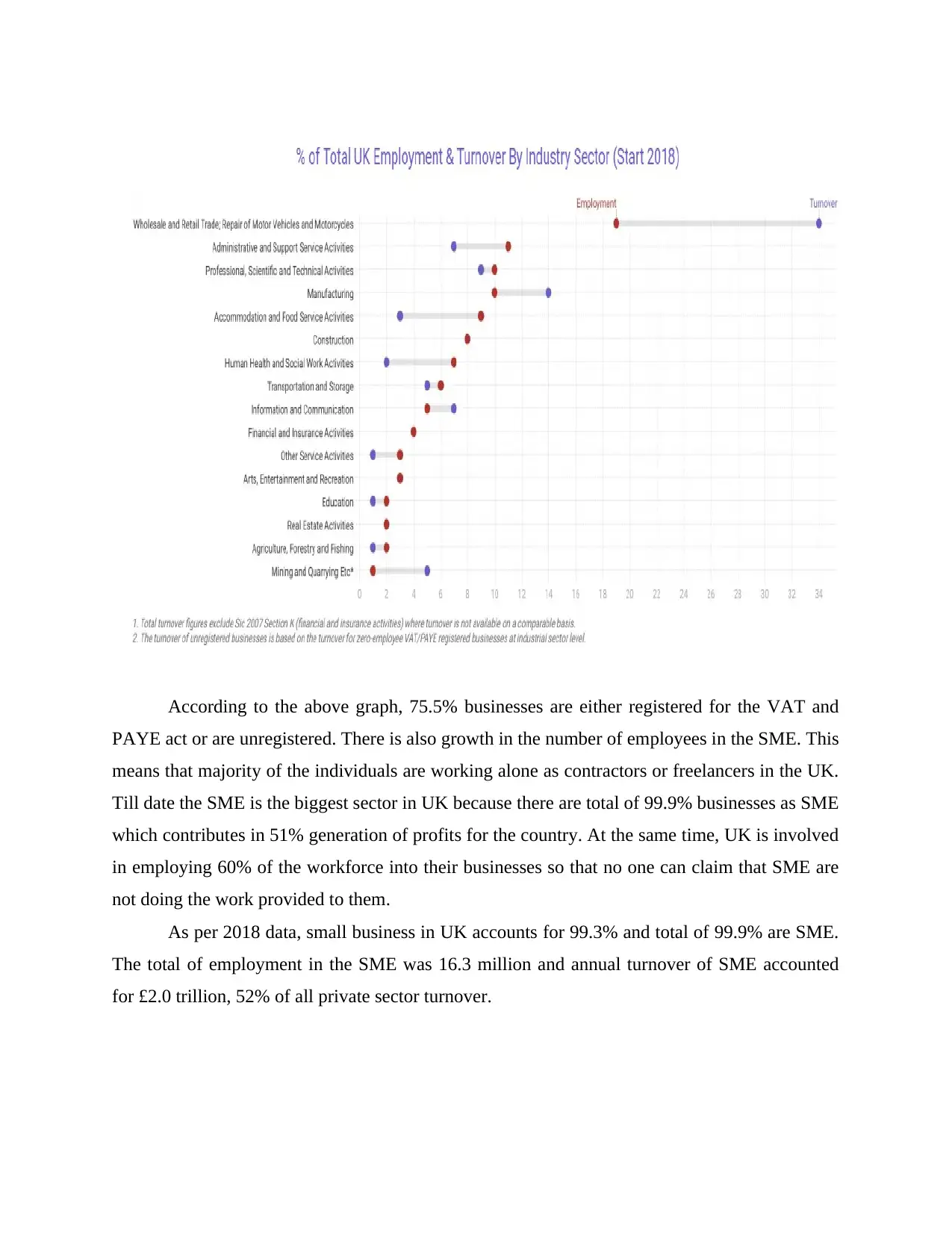
According to the above graph, 75.5% businesses are either registered for the VAT and
PAYE act or are unregistered. There is also growth in the number of employees in the SME. This
means that majority of the individuals are working alone as contractors or freelancers in the UK.
Till date the SME is the biggest sector in UK because there are total of 99.9% businesses as SME
which contributes in 51% generation of profits for the country. At the same time, UK is involved
in employing 60% of the workforce into their businesses so that no one can claim that SME are
not doing the work provided to them.
As per 2018 data, small business in UK accounts for 99.3% and total of 99.9% are SME.
The total of employment in the SME was 16.3 million and annual turnover of SME accounted
for £2.0 trillion, 52% of all private sector turnover.
PAYE act or are unregistered. There is also growth in the number of employees in the SME. This
means that majority of the individuals are working alone as contractors or freelancers in the UK.
Till date the SME is the biggest sector in UK because there are total of 99.9% businesses as SME
which contributes in 51% generation of profits for the country. At the same time, UK is involved
in employing 60% of the workforce into their businesses so that no one can claim that SME are
not doing the work provided to them.
As per 2018 data, small business in UK accounts for 99.3% and total of 99.9% are SME.
The total of employment in the SME was 16.3 million and annual turnover of SME accounted
for £2.0 trillion, 52% of all private sector turnover.

P4. Importance of small businesses and start ups to the growth of the social economy
Small business and start-ups are increasing in the UK and are treated as backbone for
economy of the country. This is crucial because it helps in driving growth and development of
the country, provides opportunity for opening new and innovative market and generates ample of
job opportunities for the local people (Ibrahim, Abdullah and Ismail, 2016). This plays a vital
role in adding value and worth to the manufacturing sector and maximises the rate of GDP. It
supports in justifying the obstacle of balance of payment account with the help of its export
promotions. Apart from this, the large business organisations contributes in maximising the gap
between richer and poor people as there is unequal distribution of wealth and income but SME
contributes a lot in equitable distribution of wealth of income. This provides immense
opportunities to the potential and capable entrepreneurs who are in hunt for suitable opportunity
and growth where they can show their hidden talent and skill. The major benefit which is
provided by the SME is low level of risk which induces more resources by large number of
labour force. There will also be transformation of resources and the local people will be able to
improve their living standard through substantial income and growth.
Furthermore, this helps in promoting stability of the business environment where the
entrepreneurs will be able to contribute in the growth and development of the economy. Apart
from all the above contributions, the support from the SME will enhance the restructuring of the
large organisations and by this, the overall efficiency and productivity of the company will be
maximised (Hundera, 2014). The maximisation in the number of SME will bring in the immense
flexibility to the overall society and economy and this may also leads to the facilitation of
technological innovation.
TASK3 & TASK4
Covered in PPT
CONCLUSION
From the above file, it has been concluded that entrepreneurship is the most ever-
changing procedure which supports in developing additive financial condition and advanced
products and services which are of crucial importance for the attainment of desired set of
objectives and leading the business to the greater heights and success. It is considered to be one
Small business and start-ups are increasing in the UK and are treated as backbone for
economy of the country. This is crucial because it helps in driving growth and development of
the country, provides opportunity for opening new and innovative market and generates ample of
job opportunities for the local people (Ibrahim, Abdullah and Ismail, 2016). This plays a vital
role in adding value and worth to the manufacturing sector and maximises the rate of GDP. It
supports in justifying the obstacle of balance of payment account with the help of its export
promotions. Apart from this, the large business organisations contributes in maximising the gap
between richer and poor people as there is unequal distribution of wealth and income but SME
contributes a lot in equitable distribution of wealth of income. This provides immense
opportunities to the potential and capable entrepreneurs who are in hunt for suitable opportunity
and growth where they can show their hidden talent and skill. The major benefit which is
provided by the SME is low level of risk which induces more resources by large number of
labour force. There will also be transformation of resources and the local people will be able to
improve their living standard through substantial income and growth.
Furthermore, this helps in promoting stability of the business environment where the
entrepreneurs will be able to contribute in the growth and development of the economy. Apart
from all the above contributions, the support from the SME will enhance the restructuring of the
large organisations and by this, the overall efficiency and productivity of the company will be
maximised (Hundera, 2014). The maximisation in the number of SME will bring in the immense
flexibility to the overall society and economy and this may also leads to the facilitation of
technological innovation.
TASK3 & TASK4
Covered in PPT
CONCLUSION
From the above file, it has been concluded that entrepreneurship is the most ever-
changing procedure which supports in developing additive financial condition and advanced
products and services which are of crucial importance for the attainment of desired set of
objectives and leading the business to the greater heights and success. It is considered to be one
Secure Best Marks with AI Grader
Need help grading? Try our AI Grader for instant feedback on your assignments.

of the most important aspect in the present business world because people are adopting this
concept and wants to do the work as per their own terms and conditions.
concept and wants to do the work as per their own terms and conditions.

REFERENCE
Books and Journals
Hundera, M. B., 2014. Micro and small scale enterprises (MSEs) development services in
women’s entrepreneurial start-ups in Ethiopia: A study conducted in three cities: Dire
Dawa, Harar and Jigjiga. Journal of Behavioural Economics, Finance,
Entrepreneurship, Accounting and Transport.2(4). pp.77-88.
Ibrahim, Z., Abdullah, F. and Ismail, A., 2016. International business competence and small and
medium enterprises. Procedia-Social and Behavioral Sciences.224. pp.393-400.
Lanahan, L., 2016. Multilevel public funding for small business innovation: a review of US state
SBIR match programs. The Journal of Technology Transfer.41(2). pp.220-249.
Mohammed, S., Baburo, T.A.B. and Karage, A. I., 2014. Assessing Impact of Entreprenuership
Eduaction on Students’ Job Creation Ability after Graduation. European Journal of
Business and Management.5. pp.62-71.
Ogunyomi, P. and Bruning, N. S., 2016. Human resource management and organizational
performance of small and medium enterprises (SMEs) in Nigeria. The International
Journal of Human Resource Management.27(6). pp.612-634.
Omar, S. S., 2015. The entrepreneurial network of Muslim women entrepreneurs: The study of
multiple-cases of small businesses in the southern region of Malaysia. International
Journal of Economics and Financial Issues.5(1S). pp.106-115.
Omar, S. S., and. et. al., 2015. Small business growth: A review of literature from the tipping
points and social network perspectives. Advanced Science Letters.21(5). pp.1089-1093.
Parida, V. and Örtqvist, D., 2015. Interactive effects of network capability, ICT capability, and
financial slack on technology‐based small firm innovation performance. Journal of
Small Business Management.53, pp.278-298.
Purnama, C. and Subroto, W. T., 2016. Competition Intensity, Uncertainty Environmental on
The Use of Information Technology and Its Impact on Business Performance Small and
Medium Enterprises. International Review of Management and Marketing.6(4). pp.984-
992.
Rafiki, A., 2014. Determinants on the obtainment of halal certification among small firms. World
Applied Sciences Journal.32(1). pp.47-55.
Yuniar, G. N., 2015. Development of MSMEs (Micro, Small and Medium Enterprises) by Baitul
Maal Wat Tamwil (BMT) as an Instrument for Poverty Reduction. Advances in
Economics and Business.3(2). pp.41-44.
Online
UK SME Data, Stats & Charts. 2019. [Online]. Available Through:
<https://www.merchantsavvy.co.uk/uk-sme-data-stats-charts/>.
Books and Journals
Hundera, M. B., 2014. Micro and small scale enterprises (MSEs) development services in
women’s entrepreneurial start-ups in Ethiopia: A study conducted in three cities: Dire
Dawa, Harar and Jigjiga. Journal of Behavioural Economics, Finance,
Entrepreneurship, Accounting and Transport.2(4). pp.77-88.
Ibrahim, Z., Abdullah, F. and Ismail, A., 2016. International business competence and small and
medium enterprises. Procedia-Social and Behavioral Sciences.224. pp.393-400.
Lanahan, L., 2016. Multilevel public funding for small business innovation: a review of US state
SBIR match programs. The Journal of Technology Transfer.41(2). pp.220-249.
Mohammed, S., Baburo, T.A.B. and Karage, A. I., 2014. Assessing Impact of Entreprenuership
Eduaction on Students’ Job Creation Ability after Graduation. European Journal of
Business and Management.5. pp.62-71.
Ogunyomi, P. and Bruning, N. S., 2016. Human resource management and organizational
performance of small and medium enterprises (SMEs) in Nigeria. The International
Journal of Human Resource Management.27(6). pp.612-634.
Omar, S. S., 2015. The entrepreneurial network of Muslim women entrepreneurs: The study of
multiple-cases of small businesses in the southern region of Malaysia. International
Journal of Economics and Financial Issues.5(1S). pp.106-115.
Omar, S. S., and. et. al., 2015. Small business growth: A review of literature from the tipping
points and social network perspectives. Advanced Science Letters.21(5). pp.1089-1093.
Parida, V. and Örtqvist, D., 2015. Interactive effects of network capability, ICT capability, and
financial slack on technology‐based small firm innovation performance. Journal of
Small Business Management.53, pp.278-298.
Purnama, C. and Subroto, W. T., 2016. Competition Intensity, Uncertainty Environmental on
The Use of Information Technology and Its Impact on Business Performance Small and
Medium Enterprises. International Review of Management and Marketing.6(4). pp.984-
992.
Rafiki, A., 2014. Determinants on the obtainment of halal certification among small firms. World
Applied Sciences Journal.32(1). pp.47-55.
Yuniar, G. N., 2015. Development of MSMEs (Micro, Small and Medium Enterprises) by Baitul
Maal Wat Tamwil (BMT) as an Instrument for Poverty Reduction. Advances in
Economics and Business.3(2). pp.41-44.
Online
UK SME Data, Stats & Charts. 2019. [Online]. Available Through:
<https://www.merchantsavvy.co.uk/uk-sme-data-stats-charts/>.
1 out of 12
Related Documents
Your All-in-One AI-Powered Toolkit for Academic Success.
+13062052269
info@desklib.com
Available 24*7 on WhatsApp / Email
![[object Object]](/_next/static/media/star-bottom.7253800d.svg)
Unlock your academic potential
© 2024 | Zucol Services PVT LTD | All rights reserved.





